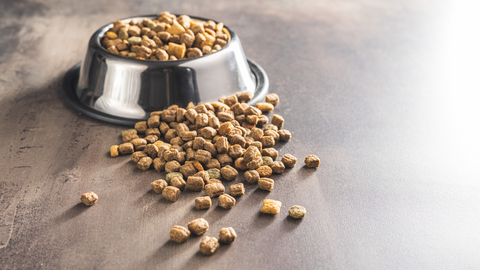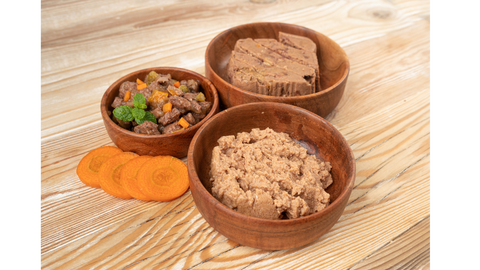Best Dog Food - A Selection Guide
We all want to ensure our doggo can maintain all-round good health, and it’s no secret that good health starts with a complete and balanced diet that is appropriate for the individual condition and nutritional requirements of your dog.

When selecting the best dog food for your dog, it’s important to consider:
-
Life Stage: Choose a food appropriate for your dog's life stage (puppy, adult, senior) to meet their specific nutritional needs. Some brands have puppy, adult and senior specifically where as other brands are suitable for all life stages!
-
Ingredients: Look for high-quality, whole food ingredients without artificial additives or fillers.
-
Protein Content: Ensure the food contains adequate protein from animal sources to support muscle health and overall well-being.
-
Nutritional Balance: Check that the food provides a balanced mix of protein, carbohydrates, fats, vitamins, and minerals.
-
Special Dietary Needs: Consider any special dietary needs your dog may have, such as allergies, sensitivities, or medical conditions.
-
Brand Reputation: Choose a reputable brand known for producing high-quality, safe, and nutritious dog food.
-
Price and Value: Its important to understand your budget when it comes to choosing a pet food. Different types of food vary in costs, as well as ingredients so be sure to have a look at each products inclusions. Some brands may markup their prices simply because of their reputation, without necessarily offering superior ingredients or nutritional benefits. Always check the ingredients and the source.
- Personal lifestyle and choice: Factors such as convenience, accessibility, and preferences determine whether one opts for kibble, canned, freeze-dried, or raw diets.
Ultimately, the best dog food is one that provides optimal nutrition for your dog's health and well-being within your budget constraints. Whether you choose a well-known brand or a lesser-known alternative, the key is to prioritize ingredients and nutritional balance to ensure that your dog receives the nutrients they need to thrive.
Common Types of Dog Food
Good nutrition starts by selecting the most suitable type of dog food for your pooch, while also considering what your personal preferences are in terms of convenience, shelf life and affordability.
There are a variety of types of dog food you can select from. The most common types of dog food include:
- Raw (BARF)
- Freeze Dried
- Air Dried
- Dry (Kibble)
- Canned / Wet
Raw/BARF

A raw or Biologically Appropriate Raw Food (BARF) diet consists of raw meat (including organs and bones), fruit and vegetables.
It is usually made up of 70% Meat, 10% Bones, 10% Organs, 10% Fruits and Vegetables.
This diet is often based on the belief that it closely resembles what dogs would eat in the wild, and offers several potential benefits for canine health.
A typical raw food diet for dogs may include:
-
Raw Meat: This is the primary component of a raw food diet and can include various types of meat such as beef, chicken, turkey, lamb, or fish.
-
Raw Bones: Raw bones are often included to provide calcium, phosphorus, and dental benefits. However, it's important to choose bones that are appropriate for your dog's size and chewing ability to avoid the risk of choking or dental fractures.
-
Raw Organs: Organ meats such as liver, kidney, and heart are rich in essential nutrients like vitamins A, B, D, E, and K, as well as minerals like iron and zinc.
-
Fruits and Vegetables: Some raw food diets include small amounts of fruits and vegetables to provide additional vitamins, minerals, and fiber.
Positives: Nutritional benefits, improved digestion, healthier skin and coat, dental health.
Negatives: $$$, Potential risk if not from a credible brand
Freeze Dried

Freeze-dried dog food is a type of dog food that undergoes a preservation process called freeze-drying. In this process, the food is frozen at -20°C to -50°C and then the moisture is removed through a vacuum process, which turns it into a dry, lightweight form.
Freeze-drying helps to preserve the nutrients, flavor, and texture of the food without the need for artificial preservatives. It's often considered a more natural way of preserving food compared to other methods like dehydration or canning, as it retains more of the original characteristics of the ingredients.
Freeze-dried dog food typically comes in the form of raw or cooked meat, fruits, vegetables, and sometimes grains. Some dog owners prefer freeze-dried food because it's convenient to store, easy to transport, and can be rehydrated with water before serving, making it a popular option for those who travel with their pets or prefer the benefits of raw food without the hassle of refrigeration.
Positives: Nutritional retention, long shelf life, lightweight, minimal processing
Negatives: $$$$$, Requires rehydration, limited availability, texture
Air Dried
Air-dried dog food is another type of dog food that undergoes a preservation process, but instead of freeze-drying, it is air-dried. In air-drying, the food is gently cooked at low temperatures between 60-90°C, and then warm air is circulated to remove the moisture slowly over a period of time.
This method preserves the natural nutrients, flavor, and texture of the ingredients while removing the moisture content, making the food shelf-stable without the need for artificial preservatives. The slow drying process helps to retain the nutritional integrity of the ingredients, similar to freeze-drying.
Air-dried dog food often contains a combination of meats, fruits, vegetables, and sometimes grains. It's typically considered a premium option because of its minimal processing and high-quality ingredients. Like freeze-dried food, air-dried dog food is convenient for storage, transportation, and feeding, making it popular among pet owners looking for a nutritious and convenient diet option for their dogs.
Positives: Texture and taste, long shelf life, lightweight, minimal processing, no rehydration required
Negatives: $$$, limited availability, lack of variety
Lightly Cooked

Lightly cooked dog food refers to a type of dog food that undergoes a cooking process where ingredients are cooked at lower temperatures and for shorter durations of compared to traditional cooking methods.
In general, this may mean that fresh ingredients steamed, boiled or cooked at temperatures between 75-90°C.
Positives: Taste, minimal processing, improved digestion
Negatives: $$$, short shelf life, inconvenient, lack of texture
Dry/Kibble
Dry dog food, also known as kibble, is a type of dog food that has been processed to remove most of its moisture content, resulting in a dry, crunchy texture. It is one of the most popular and widely available forms of dog food.
Dry dog food is typically made from a combination of ingredients such as meat, grains, vegetables, and vitamins and minerals. These ingredients are mixed together, cooked and extruded to form the familiar kibble shape. The cooking process kills harmful bacteria and helps to make the food more digestible for dogs.
Positives: Taste, Convenient, Long Shelf Life, Variety, Affordable
Negatives: Range of quality and transparency, Some nutritional loss
Wet/Canned

Wet or canned dog food is a type of dog food that comes in a moist, semi-liquid form and is typically packaged in cans or pouches. Unlike dry dog food, which has had most of its moisture removed, wet dog food contains a higher water content, giving it a softer texture.
Wet dog food is made from a variety of ingredients, including meat (such as beef, chicken, turkey, or fish), grains, vegetables, and vitamins and minerals. These ingredients are cooked together, often in a broth or gravy, to create a flavorful meal for dogs.
Positives: Taste, Convenient, Long Shelf Life, Variety, Affordable
Negatives: Poor Quality Ingredients, Dental Health, Packaging waste, Short shelf life when opened.
Home Made
Some dog owners prefer to prepare and cook their dog’s meals themselves. This allows dog owners to have complete control over what is included in their dog’s diet, however it can be time consuming and expensive.
It’s important to seek appropriate nutritional advice from your veterinarian before introducing a home-cooked diet to ensure it will meet your dog’s nutritional requirements.
Positives: Taste, control over ingredients
Negatives: Cost, Time consuming, inconvenient, short shelf life, risk of being imbalanced
Understanding Dog Food Labels
The information contained on dog food labels is the best way to determine the quality and contents of what you are feeding your dog.
Here are some things to look for when checking dog food labels:
- Ingredients: Pet food manufacturers are legally required to individually list the ingredients included in their products in descending order of the quantity included. Checking the list of ingredients will ensure you know what you’re feeding you dog and the approximate quantities.
- Human grade: The label should specify if the dog food is “human grade” or “feed grade”. Where a dog food label specifies the term “feed grade”, it’s a good indication that the ingredients are of poorer quality.
- Nutrients: Dogs require six essential nutrients to maintain good health—water, proteins, fats, carbohydrates, vitamins and minerals. While the label won’t specify which ingredients provide each nutrient, they should list a minimum percentage of crude protein and crude fat, as well as a maximum percentage of crude fibre and moisture.
- Natural and preservative free: This indicates that ingredients are derived solely from plant, animal or mined sources and are free from preservatives.
-
Complete and balanced: Complete and Balanced should be the bare minimum when looking at a food label. This means the food contains all the essential nutrients for your dog to survive, but not necessarily thrive. Look for labels that "exceed AAFCO requirements, which means they are going above and beyond the minimum requirments dogs need for a complete and balanced meal!
Evaluating Your Dog’s Nutritional Requirements

A dog’s nutritional requirements can vary based on a range of factors, including their age, size and weight, activity level and condition.
Before settling on what you believe the best dog food is, it’s important to evaluate your dog to determine what their individual nutritional requirements are.
Age
The nutritional requirements of dogs will change depending on their life stage.
For example: younger dogs require more fat and protein to aid growth and brain development; adult dogs need sufficient nutrients to satisfy their energy needs and to repair body tissues; and older dogs require a diet which is lower fat but higher in vitamin E and Beta-Carotene to keep their weight in-check and promote a strong immune system.
Size and Weight
Large and small dogs each have different nutritional needs.
Smaller breeds have a fast metabolism which means they can consume a higher calorie diet, while larger breeds need a diet which supports strong and healthy bones and joints.
Activity Level
The activity level of your dog will also determine how much food they need.
Highly active dogs will tolerate a higher calorie diet far better than more sedentary dogs. Overfeeding your dog can also quickly lead to obesity. If your dog becomes overweight, they will require smaller portions of foods containing a moderate amount of fat and fermentable fibre to be able to return to a healthy weight.
Condition
Dogs who have a specific medical condition will also require some alterations to their diet. For example, pregnant or nursing dogs will need to consume significantly more calories than they would normally.
If your dog is suffering from a specific medical condition, it’s important to listen to the nutritional advice provided by your veterinarian.
Designing the Ideal Diet for Your Dog
While some dog owners opt to follow an exclusively raw or dry food diet, others prefer a mixed approach offering a combination of both raw and dry foods.
For most dogs, there won’t be one single option which represents the best dog food at every stage of their life. Most dogs will require some slight adjustments throughout their life to suit their changing nutritional needs.
If you exclusively feed your dog a dry or cooked diet and are and considering transitioning to a raw or mixed diet, it’s a good approach to keep meals relatively simple at first to avoid introducing too many new ingredients. Try starting by introducing a lean white-meant protein like chicken, before moving on to red-meat proteins like beef or kangaroo.
You should speak to your veterinarian if you are unsure about what your dog’s nutritional requirements are.
Selecting the Best Dog Food Supplier
It’s also important to find out more about your dog food supplier. To evaluate a dog food supplier, it may help to consider things such as:
- The quality of their products (e.g. Are the Australian made? Do they only include natural ingredients?).
- Product packaging (e.g. Is it eco-friendly? Will it prolong the shelf life? Are potions easy to store?).
- Do they provide good service (e.g. Do they offer home delivery? Can they provide customised meal plans?).
- Value for money (e.g. Will you receive a good quality product for an affordable price?).

At Petzyo, it’s our mission to deliver the most bang for your buck with premium quality meal plans tailored to your dog’s individual requirements delivered to your door at a lower price than our competitors.





